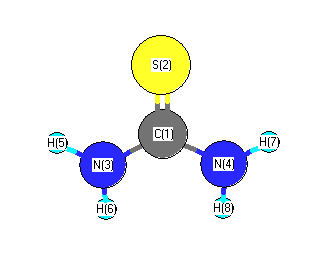Vibrational Frequencies calculated at TPSSh/cc-pVTZ
| Mode Number |
Symmetry |
Frequency
(cm-1) |
Scaled Frequency
(cm-1) |
IR Intensities
(km mol-1) |
Raman Act
(Å4/u) |
Dep P |
Dep U |
|---|
| 1 |
A |
3676 |
3560 |
16.15 |
|
|
|
| 2 |
A |
3547 |
3434 |
6.11 |
|
|
|
| 3 |
A |
1652 |
1599 |
64.81 |
|
|
|
| 4 |
A |
1410 |
1366 |
258.47 |
|
|
|
| 5 |
A |
1066 |
1032 |
59.15 |
|
|
|
| 6 |
A |
765 |
740 |
8.92 |
|
|
|
| 7 |
A |
508 |
492 |
40.11 |
|
|
|
| 8 |
A |
443 |
429 |
7.53 |
|
|
|
| 9 |
A |
359 |
347 |
120.97 |
|
|
|
| 10 |
B |
3676 |
3559 |
55.66 |
|
|
|
| 11 |
B |
3540 |
3427 |
35.99 |
|
|
|
| 12 |
B |
1627 |
1576 |
197.45 |
|
|
|
| 13 |
B |
1427 |
1381 |
92.68 |
|
|
|
| 14 |
B |
1065 |
1031 |
19.78 |
|
|
|
| 15 |
B |
632 |
612 |
10.41 |
|
|
|
| 16 |
B |
588 |
569 |
90.60 |
|
|
|
| 17 |
B |
392 |
379 |
297.92 |
|
|
|
| 18 |
B |
387 |
374 |
3.30 |
|
|
|
Unscaled Zero Point Vibrational Energy (zpe) 13377.9 cm
-1
Scaled (by 0.9683) Zero Point Vibrational Energy (zpe) 12953.9 cm
-1
See section
III.C.1 List or set vibrational scaling factors
to change the scale factors used here.
See section
III.C.2
Calculate a vibrational scaling factor for a given set of molecules
to determine the least squares best scaling factor.
Charges, Dipole, Quadrupole and Polarizability
Charges from optimized geometry at TPSSh/cc-pVTZ
Charges (e)
| Number |
Element |
Mulliken |
CHELPG |
AIM |
ESP |
| 1 |
C |
0.182 |
|
|
|
| 2 |
S |
-0.396 |
|
|
|
| 3 |
N |
-0.208 |
|
|
|
| 4 |
N |
-0.208 |
|
|
|
| 5 |
H |
0.174 |
|
|
|
| 6 |
H |
0.141 |
|
|
|
| 7 |
H |
0.174 |
|
|
|
| 8 |
H |
0.141 |
|
|
|
Electric dipole moments
Electric dipole components in Debye
(What's a Debye? See section
VII.A.3)
| |
x |
y |
z |
Total |
| |
0.000 |
0.000 |
-5.007 |
5.007 |
| CHELPG |
|
|
|
|
| AIM |
|
|
|
|
| ESP |
|
|
|
|
Electric Quadrupole moment
Quadrupole components in D Å
Polarizabilities
Components of the polarizability tensor.
Units are
Å
3 (Angstrom cubed)
Change units.
| |
x |
y |
z |
| x |
4.212 |
0.186 |
0.000 |
| y |
0.186 |
7.252 |
0.000 |
| z |
0.000 |
0.000 |
10.010 |
<r2> (average value of r
2) Å
2
| <r2> |
101.486 |
| (<r2>)1/2 |
10.074 |
